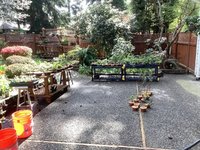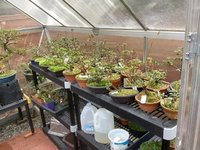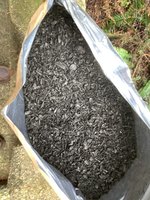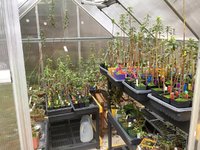Deep Sea Diver
Masterpiece
Wondering the pluses and minuses of moving this discussion to @sorce thread…. Will wait on that decision. Staying here for the moment…
So ok, I’ve rootwashed over 70 trees, azaleas and maples, this spring and am working into the backstretch. Perhaps 15- 20 3-4 year old azaleas to go. With all that amount of water going my brain is running amok. (And I seem to need more bathroom breaks! ).
).
Lately my thoughts have been circling the drain on Biochar…. Pluses and minuses. These are pretty well laid out in the most recent comprehensive scientific Biochar literature review. Here’s what I’m thinking…..
Biochar isn’t a miracle additive and I’m a pondering about three potential risk factors and one very minor concern.
First the potential to clog up a media faster then normal with the Biochar particles . Yet if it works the root growth may clog up the works faster anyways, necessitating repotting.
Second, Improved growth. A double edged sword. Good for establishing primary structure and initial stages of development. Maybe not so good for refinement…. Or maybe the effect is just continued overall good health in refinement, more robust… or not...
Third - Dosage. Perhaps this should actually be the first! Anyways no dosage has been set for trees that I can find, let alone bonsai. I merely interpolated from the manufacturers garden recommendations. A bit scary, at least on the surface. Hence my trials. I wrote the Wakefield Biochar folks for advice… we shall see if they come through.
Minor concern - possiblity of needing more pesticide, if needed. Biochar has been reported to absorb pesticides to some extent. Not worrying about H2O2 of course, but imidiploprid which is used sparingly after flowering against lacebugs. It’s a neonicotide and I don’t want to up my dosage.
btw: More azaleas out to play in the wide open spaces as of yesterday... more to come

cheers
DSD sends
So ok, I’ve rootwashed over 70 trees, azaleas and maples, this spring and am working into the backstretch. Perhaps 15- 20 3-4 year old azaleas to go. With all that amount of water going my brain is running amok. (And I seem to need more bathroom breaks!
Lately my thoughts have been circling the drain on Biochar…. Pluses and minuses. These are pretty well laid out in the most recent comprehensive scientific Biochar literature review. Here’s what I’m thinking…..
Biochar isn’t a miracle additive and I’m a pondering about three potential risk factors and one very minor concern.
First the potential to clog up a media faster then normal with the Biochar particles . Yet if it works the root growth may clog up the works faster anyways, necessitating repotting.
Second, Improved growth. A double edged sword. Good for establishing primary structure and initial stages of development. Maybe not so good for refinement…. Or maybe the effect is just continued overall good health in refinement, more robust… or not...
Third - Dosage. Perhaps this should actually be the first! Anyways no dosage has been set for trees that I can find, let alone bonsai. I merely interpolated from the manufacturers garden recommendations. A bit scary, at least on the surface. Hence my trials. I wrote the Wakefield Biochar folks for advice… we shall see if they come through.
Minor concern - possiblity of needing more pesticide, if needed. Biochar has been reported to absorb pesticides to some extent. Not worrying about H2O2 of course, but imidiploprid which is used sparingly after flowering against lacebugs. It’s a neonicotide and I don’t want to up my dosage.
btw: More azaleas out to play in the wide open spaces as of yesterday... more to come

cheers
DSD sends








